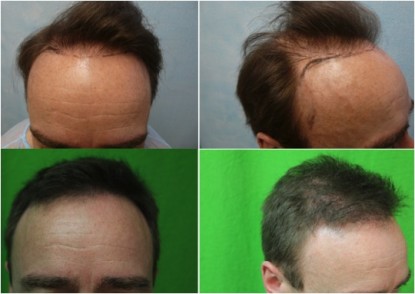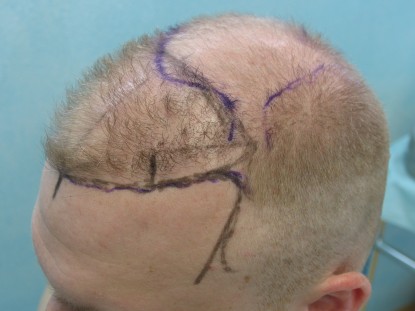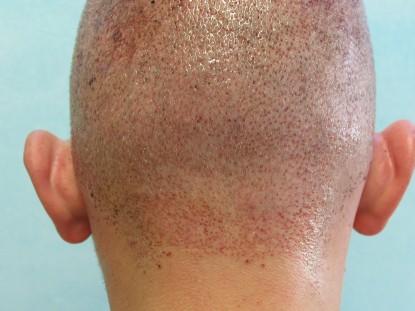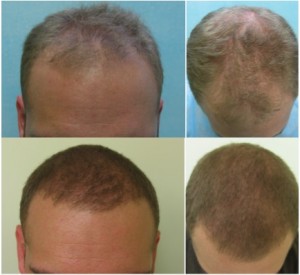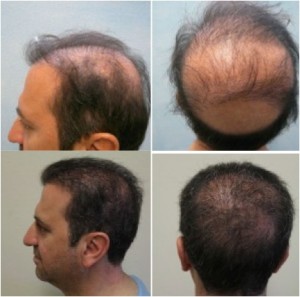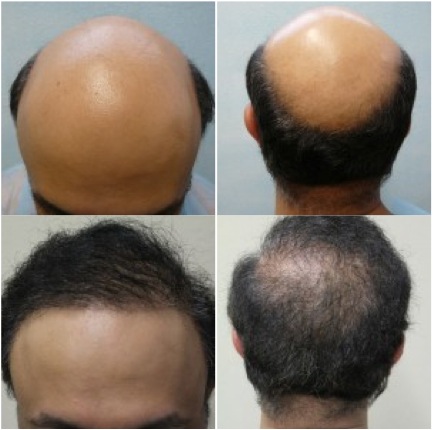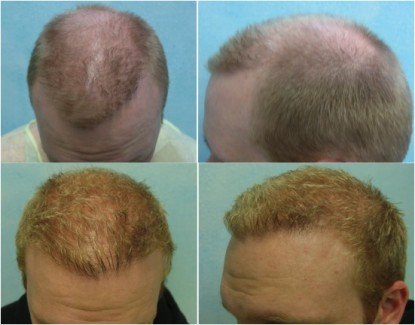FUE Hair Transplant Surgery
Source: dermhairclinic.com
WHAT IS AN FUE HAIR TRANSPLANT?
Hair transplantation originated in Japan in the early 1900s and has evolved greatly over the past century. In the 1980s, as part of this evolution, came the advent of follicular unit extraction (FUE). FUE, wherein the practitioner extracts follicular units (natural groupings of 1 to 4 hairs) one at a time, is now the ideal method of extraction for hair transplantation.
FUE method of transplantation is a no-stitch procedure that involves implanting the grafted follicular units into the balding recipient area. While FUE hair transplantation requires the practitioner to possess a higher skill set in order to perform the procedure successfully, this technique continually yields the most successful outcomes in hair density, natural-looking hairlines, and minimized scarring. FUE hair transplantation is generally pursued for the treatment of androgenic alopecia, also known as pattern baldness. This genetic hair loss condition results in balding of the crown, front, hairline, and temple points. But with the innovations of the Follicular Unit Extraction, it is nearly impossible to tell a natural head of hair from one that has undergone hair transplantation.
PREPARING FOR FOLLICULAR UNIT EXTRACTION
Once you’ve had a one on one consultation with your physician and decided to proceed, you will be given the necessary instructions to prepare yourself for your day of surgery. Some of these instructions may be tailored to your particular needs. Put the instructions into place whenever specified and follow them carefully. On the morning of your surgery, you should have a bountiful breakfast and arrive with a thoroughly shampooed scalp. Upon arrival at the clinic, “before” photographs will be taken of you. The donor area, being the back of the head in most cases, will then be shaved and prepared for surgery.
WHAT HAPPENS DURING AN FUE PROCEDURE?
First, the patient is made to lie face down on the operating table. Local anesthesia will be administered to the donor area, as well as intramuscular hypnotics for the patient to ingest orally, for the purpose of relaxation.
Your surgeon will then begin to extract carefully selected follicular units from the donor area. The surgeon will use a micropunching tool, needle devices, and magnification for the extraction process. (Vacuum-based mass production machines may compromise your results, and robots lack the necessary human touch that contributes to an optimal procedure. These mass production line cookie cutter FUE machines are at their primitive stages of development with much room for improvement. They are no substitute for an experienced FUE surgeon with a verifiable portfolio of patient results.) Each follicle extracted may consist of anywhere from one to four, or even five hairs. The extracted grafts are then preserved in a holding solution. This part of the surgery is the most laborious and time-consuming, since unlicensed technicians are legally forbidden to perform follicular extraction. Your FUE surgeon or an experienced associate (one who is licensed to perform surgery by the state) should perform this entire process himself, to ensure the integrity of each extracted graft.
Body and facial hair are harvested in a similar but more nuanced manner by experienced practitioners, skilled in advanced forms of FUE hair transplant.
After all extractions have been done, the patient can turn over to sit face up. Many would use this time to listen to music, or watch a movie or television. Local anesthesia will be administered to the bald recipient area at this time. Using customized blades, microscopic slits are made in this area for implantation of the extracted follicles. Implantation of the follicles is the step requiring the highest level of skill, as the resulting design or “look” is determined by the slit preparation. Hairline creation, which should have been discussed in detail during your consultation, happens here. The hairline is the most creative work in the FUE hair transplant process. The utmost care is given to produce a natural looking hairline. In order to achieve this, the follicles containing a single hair are implanted at the front of the hairline to build a gradual wall of hair, which is filled in by units containing two to three hairs to provide the area with density.
During an FUE surgery at DermHair Clinic, we provide the patient with beverages intermittently and serve lunch on our pent house patio overlooking the Pacific Ocean. The patient can also take bathroom breaks whenever needed. After the procedure is done, “after” photos are taken. (The same confidentiality principles apply here as with the “before” pictures.) No stitches or dressings are used and a medical assistant will counsel the patient regarding care instructions at this time.
AFTER THE FUE PROCEDURE
After you receive detailed instructions from the medical assistant—which include everything from showering to exercising—you will be given a prescription for mild painkillers, antibiotics, and topical medication.
Signs of wounding in the donor area should deplete by day seven, as well. Typically, the donor area will continue to heal to the point where scarring is highly unnoticeable.
Scabs in the recipient area will usually fall off within seven to 14 days. This area will go through a phase of shedding until the eighth week. Typically, your FUE hair transplant will boast new hair growth by three and a half to four months, usually maxing out at 12 months. However, for up to 18 months, the new hair will continue to thicken and mature, blending in more with the surrounding hair.
WHY CHOOSE FUE HAIR TRANSPLANT OVER DIFFERENT HAIR RESTORATION OPTIONS?
There are different options for treating hair loss, not all surgical:
- Minoxidil, commonly known as Rogaine, and finasteride, commonly known as Propecia.
- Surgery is the most popular means of permanent hair restoration with three main techniques at the forefront:
- scalp reduction
- temporoparieto-occipital (TPO) flaps and other variations of flaps
- Punch graft, minigrafts, and micrografts
- Hair transplantation, including follicular unit strip surgery and FUE hair transplant
Scalp reduction and temporoparieto-occipital flaps, or TPO flaps, have become obsolete due to consistently botched results, a high probability of permanent scarring, and the potential for nerve damage. Also, they are considered hair restoration surgeries, unlike the FUE hair transplant, which is transplantation surgery.
The FUE hair transplant is an improvement of the punch graft technique. Punch grafts are 4mm grafts which result in what we call “doll’s hair.” Another unsightly outcome of punch graft surgery is the 4mm round bald marks left permanently on the back of the head. Minigrafts and micrografts were developed as an improvement of this method, but still yield unnatural, pluggy-looking results as compared to FUE hair transplant.
FUE Hair Transplant vs Strip Surgery:
Follicular unit strip surgery (FUSS) also known as “strip harvesting,” is considered the traditional method and has been the recent leader in hair transplant surgery. FUSS extracts a strip of flesh from the rear and/or sides of the head, which will be microscopically divided to provide donor follicles for transplantation.
A disadvantage of FUSS is that it promises a permanent linear scar to be left as a result. The patient must then wear a longer hairstyle in order to conceal the scar.
FUE does not extract follicular units in a strip of flesh like FUSS. This means Follicular Unit Extraction is more labor intensive for practitioners, requires longer operation time, and is more expensive for patients. However, consumer demand agrees that the pros of FUE hair transplant as compared to FUSS far outweigh the cons. FUE hair transplantation offers:
- A less invasive procedure
- A quicker recovery time
- The possibility to use finer hairs, such as those found at the nape of the neck, to better refine the hairline
- No linear scarring; only tiny round, cosmetically negligible marks in the donor area. This also means patients will be free to wear short hair styles, not bound to long hair styles for concealing a strip scar.
- Less likelihood of permanent nerve damage.
- An infinitely larger pool of donor hair, as FUE hair transplant enables body hair transplantation (BHT)
Body Hair Transplantation:
Furthermore, advanced FUE practitioners such as Dr. Umar—a pioneer and world leader in this technique—are able to markedly broaden the pool of donor hair through the advent of body hair transplantation. BHT allows for the extraction of donor hair from the beard, chest, stomach, arms, and legs, with cosmetically negligible scarring. Patients who lack head donor hair and were therefore considered poor candidates in the past now join the ranks of potential FUE hair transplant patients.
GOOD CANDIDATES FOR FOLLICULAR UNIT EXTRACTION
Potential candidates for FUE hair transplant using head hair only are those who do not suffer a total depletion of scalp donor hair. An FUE clinic that does not practice BHT would be unable to service a patient without sufficient head hair remaining in tact.
A clinic that does put body hair transplantation into practice, such as the DermHair Clinic of Los Angeles, would be equipped to service patients whose scalp hair loss is so severe that their head donor hair is not sufficient for transplantation. This includes FUE hair transplant patients who:
- Suffer from severe pattern baldness
- Have excessive scarring from previous surgery
- Have endured some sort of accident or burn that has left them bald
POOR CANDIDATES FOR FUE PROCEDURES
While follicular unit extraction using body hair transplantation has changed the face of hair loss, there remain some people who still will not qualify for this type of surgery.
- People who lack the supply of good quality head, body, or beard hair will not be candidates for any type of FUE hair transplant, even with the use of BHT.
- There is a relative contraindication for hair transplant generally in patients who are too young, i.e., below the age of 24. This is due to the fact that a person under the age of 24 who suffers from androgenic alopecia has likely not finished balding. Also, this age group may be psychologically and financially unprepared to grasp the long term implications of hair transplant. That said, after careful counseling, even young patients can undergo an FUE hair transplant. Counseling must fully take into account: future hair loss, total available donor pool, and the patient’s ability to countenance future follow-up transplantation (which could create an unnatural look if not done).
- Some people with extremely curly or kinked follicles, such as most of African descent. These patients should ideally under go a test procedure to determine their transection rates and consequently their suitability for FUE hair transplant.
- People with an abnormal tendency to scar, as in scar hypertrophy, or keloids.
- People with bleeding or clotting abnormalities.
- People with allergies to local anesthesia.
COMPLICATIONS OF AN FUE SURGERY
Follicular unit extraction is a safe and minimally invasive method of hair transplantation. Patients can minimize their risk by following all pre- and post-procedural instructions and by selecting an experienced surgeon. However complications may yet arise even in the best of circumstances. Factors that increase the chance of complications of FUE hair transplant could include:
- Physiology of the patient
- An inexperienced practitioner
- A practitioner who values quantity over quality
- A practitioner who abdicates his skills to unlicensed personnel or flawed machines ( eg vacuum based technologies or robots that lack the human touch)
- Unknown and unforeseen complication factors may arise on rare occasion
WHY AUTOMATED FUE TECHNOLOGY IS LIMITED IN PRODUCING THE BEST HAIR TRANSPLANT RESULTS
In the opinion of the author, “hands-free” extractors such as the artas robots and vacuum suction are fraught with to many potential problems to be the answer for your FUE hair transplant. No automated device can discern a prime follicular unit as an experienced physician can, nor extract it with the care required to preserve its life for implantation into the recipient area.
These are issues common to automated FUE tools.
NeoGraft:
- Uses an air vacuum to extract donor follicles. Air exposure is detrimental to extracted hair follicles. However those who choose to undergo FUE with Neograft can request to have the suction turned off.
- When used to implant grafts, it would not allow follicles to be tightly packed into the recipient area, as the implantation device is too large for such specificity.
- Once suctioned, the follicle may experience additional trauma due to impact against the receiving tube.
- If used to place grafts in the recipient would increase the risk of buried grafts due to the relative loss of depth control. This leads to cysts and pitting on the scalp.
- Higher transection rates of up to 15% has been cited for this device although its manufacturer’s and vendors claim the transection rate is improving with time, this is difficult to ascertain at this point. In the hands of an experienced FUE practitioner a transection rate of 2-5% is common.
- Can only be used on people with straight dark brown or black hair.
- Since it uses a sharp punch followed by a dull punch, there is an increased risk of buried grafts s the dull punch may push the partially separated grafts furthe into the scalp increasing the risk of cyst formation, not to mention the graft that is damaged in the process.
- Since the machine would have punch out hundreds of grafts before the physician typical check in, if transection rates are high, many grafts would have been wasted before the procedure is aborted.
- It is a cumbersome process. The patient is placed in a particular position while an area of about 5 by 10 cm is isolated for the machine to gauge. The distance from the machine is set. The machine then goes to work. obviously any movement on the patients path would be problematic. After this area is worked, the physician then removes the grafts with a forcep. Then the process of strapping the patients head in a different position and machine calibration is done all over again. The procedure is clearly too cumbersome for the patient and not efficient when compared to an experienced FUE surgeon using a hand held device to feel around each and every grafts as it is removed. Control is by the seconds rather than between hundreds of graft separation.
FOLLICULAR UNIT EXTRACTION CONTINUES TO PROVE ITS VALUE
The FUE hair transplant is, hands down, today’s leading surgical technique for hair restoration. While it does require practitioners to take their time implementing the utmost skill, the life-changing results patients enjoy makes it a highly rewarding process overall. FUE hair transplant using body hair transplantation has also become much more widely used and accepted because of its undeniable success rates in the hands of experienced practitioners.
More specialized branches of Follicular Unit Extraction have developed. This includes an area known as facial hair to head transplant. Follicles from the beard region are extracted and inserted into areas of hair loss. This course of action is used in cases where head hair is not enough to create sufficient coverage. If you would like to read more about the applications of beard hair, click here.
